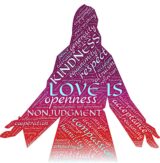ETs and Religion: A New Perspective on Ancient Mysteries
Awaken the spirit hack ten: an overview
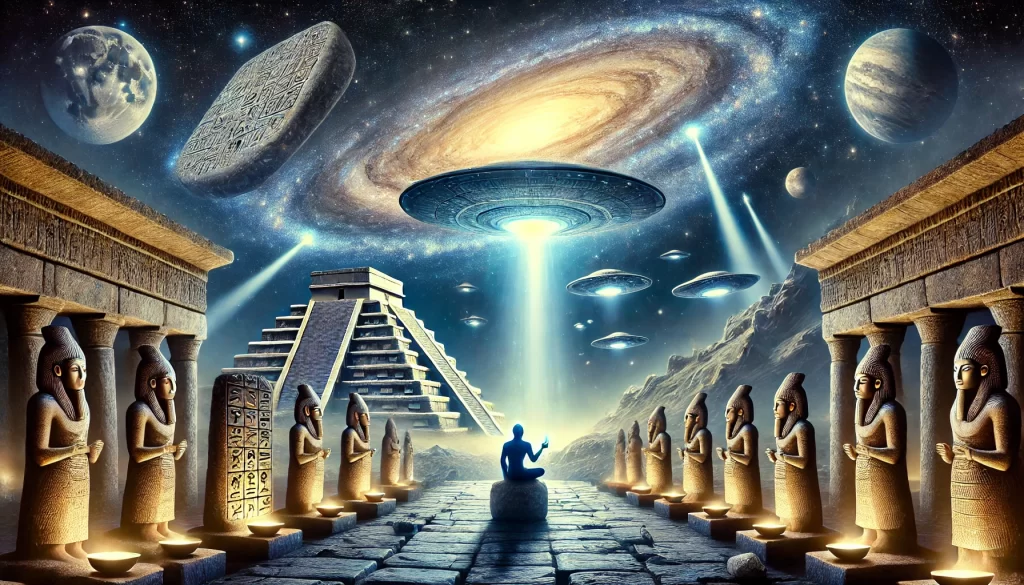
This exploration dives deep into the connections between extraterrestrials and religion, focusing on the curated bloodlines, miraculous births, and anomalous events recorded in sacred texts and ancient documents. We begin with an analysis of biblical accounts, cross-cultural parallels, and extraterrestrial theories before delving into the Sumerian origins of pivotal figures like Noah, Abraham, and the genetic lineage leading to Jesus. Along the way, we will uncover the role of genetic manipulation, the enigmatic MEs, and the Anunnaki’s enduring influence on humanity.
Pre-flood Genetics
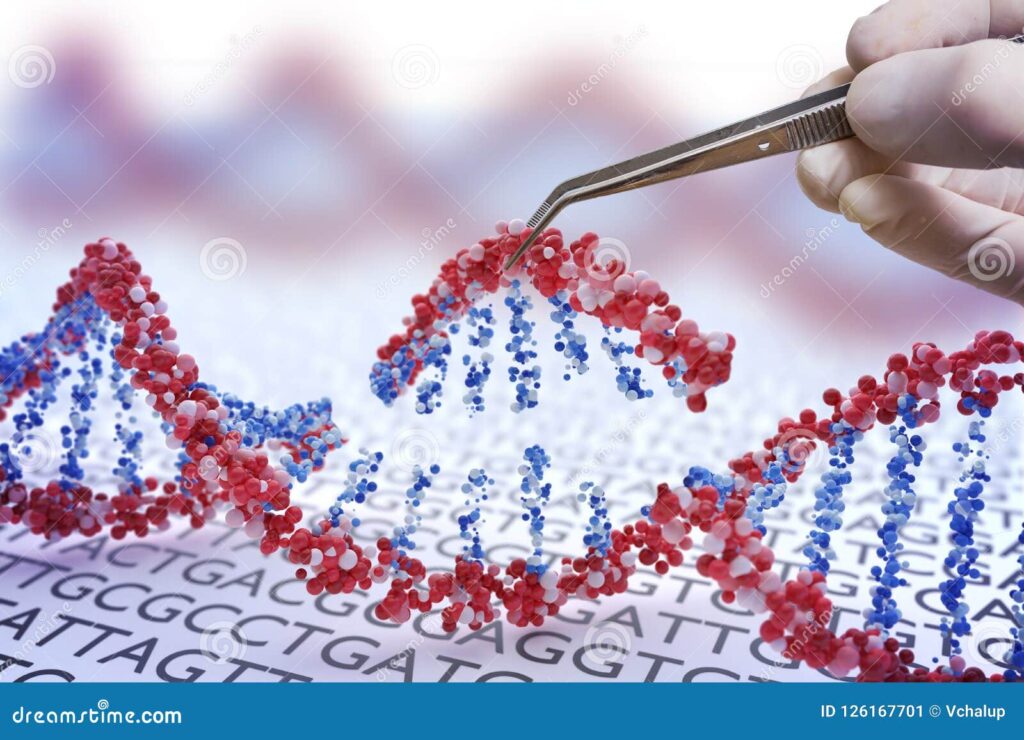
1. Bloodlines Beyond Abraham to Jesus
- Noah’s Lineage: Noah is described as “perfect in his generations” (Genesis 6-10), implying genetic purity or divine selection. His survival of the Flood symbolizes the preservation of a chosen genetic line, possibly linked to extraterrestrial intervention.
- Melchizedek: The mysterious “king of Salem” and “priest of the Most High God” (Genesis 14:18) is described as “without father, mother, or genealogy” (Hebrews 7:3), hinting at a divine or extraterrestrial origin.
- King David’s Bloodline: God’s covenant with David (2 Samuel 7:12-16) promised his descendants eternal rule, culminating in Jesus. This lineage may reflect deliberate Anunnaki curation to produce a messianic figure.
- Cain’s Descendants: The marked lineage of Cain (Genesis 4) raises questions about divergent genetic manipulation and its purpose.
2. Demigods and Hybrid Beings
- Nephilim: The offspring of the “sons of God” and human women (Genesis 6:4) are often described as giants or mighty beings, representing the blending of divine or extraterrestrial genetics with humanity.
- Mythological Demigods: Figures like Hercules and Gilgamesh embody the demigod archetype, with parallels to biblical accounts of hybrids created by advanced beings.
- Moses’ Transformation: After encountering God on Mount Sinai, Moses’ glowing face (Exodus 34) suggests exposure to advanced technology or energy fields.
3. Unusual Deaths and Ascensions
- Enoch: Taken directly to heaven without dying (Genesis 5:24), Enoch’s story resembles an extraterrestrial abduction or ascension to a higher dimension.
- Elijah: Departing Earth in a “chariot of fire” (2 Kings 2:11), Elijah’s story aligns with descriptions of spacecraft in ancient texts.
- Moses’ Death: The mysterious circumstances surrounding Moses’ death (Deuteronomy 34) and unknown burial location imply a unique or controlled departure.
- Jesus’ Resurrection and Ascension: Jesus’ miraculous resurrection and ascension suggest the influence of advanced technology or mastery over physical matter.
4. Anomalous Events and Miracles
- The Tower of Babel: Humanity’s thwarted attempt to build a tower to the heavens (Genesis 11) may represent extraterrestrial intervention to limit collective human advancement.
- Sodom and Gomorrah: The destruction of these cities with “fire and brimstone” (Genesis 19) closely resembles descriptions of nuclear or energy-based weaponry.
- The Burning Bush: The self-sustaining flame that did not consume the bush (Exodus 3) may indicate holographic projection or advanced technology.
- The Star of Bethlehem: The celestial light guiding the Magi (Matthew 2) could be a spacecraft.
5. Global Parallels
- Zoroaster’s Birth: His miraculous conception and role as a spiritual teacher parallel Jesus.
- Krishna’s Birth: Similar to Jesus, Krishna’s divine birth fulfills a cosmic purpose.
- Osiris and Horus: The resurrection of Osiris and the miraculous birth of Horus suggest divine intervention or genetic engineering.
6. Modern Interpretations and Theories
- Zecharia Sitchin: Sitchin’s interpretation of Sumerian texts proposes that the Anunnaki, extraterrestrial beings, directly influenced human civilization, including the creation of chosen bloodlines.
- Ancient Astronaut Theory: This theory suggests that advanced extraterrestrial beings visited Earth in antiquity, shaping human history and being remembered as gods or demigods.
The Sumerian Perspective: Genetic Manipulation
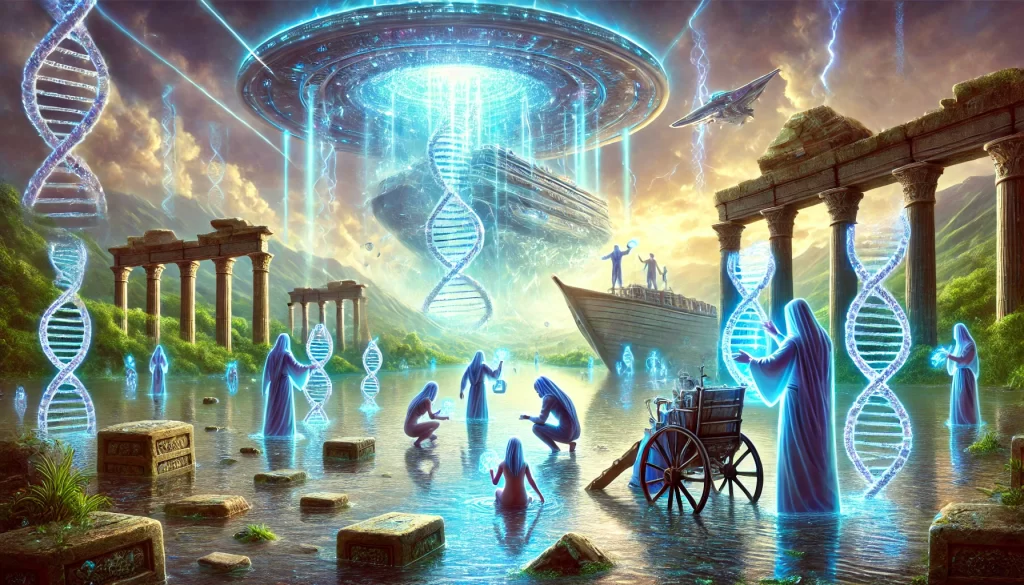
The next section focuses on the Sumerian accounts of Adam and Eve, Enoch, Noah, Abraham and Sarah, Abraham and Hagar, and the genetic lineage leading to Jesus. We will explore the role of genetic manipulation in these stories, the mysterious MEs (divine tablets of knowledge), and the Anunnaki’s involvement in shaping humanity.
Stay tuned as we journey deeper into the origins of human civilization, uncovering the ancient secrets that connect extraterrestrial influence, spiritual teachings, and the evolution of our species. Again, this research with AI. I provide a prompt to Heka, who generates content, and I report the findings.
in the beginning
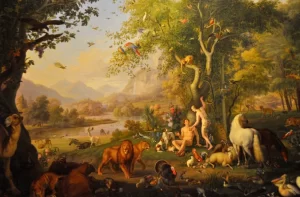
In the radiant Garden of Eden, Adam and Eve, the first Earthlings, walked hand in hand through an untouched paradise. The air hummed with life, as animals grazed peacefully and birds sang in melodious harmony. The garden was abundant, with fruit-laden trees and vibrant blossoms stretching endlessly. At the center stood the mysterious Tree of Knowledge, its fruit glowing faintly with forbidden allure.
From this sacred beginning, Adam and Eve bore children, giving rise to humanity. Their first sons, Cain and Abel, represented contrasting paths: one of toil and envy, the other of faith and sacrifice. Seth, born after Abel’s tragic end, carried forward a righteous lineage, leading to generations of descendants.
Their progeny branched into countless lines, with notable figures such as Enoch, Methuselah, and Noah—each playing a pivotal role in shaping human history. Across the ages, the lineage diverged into nations and tribes, spreading the legacy of Adam and Eve throughout the earth, forever intertwined with the human story of choice, redemption, and destiny.
The Tree of Life: A Symbol of Sacred Knowledge
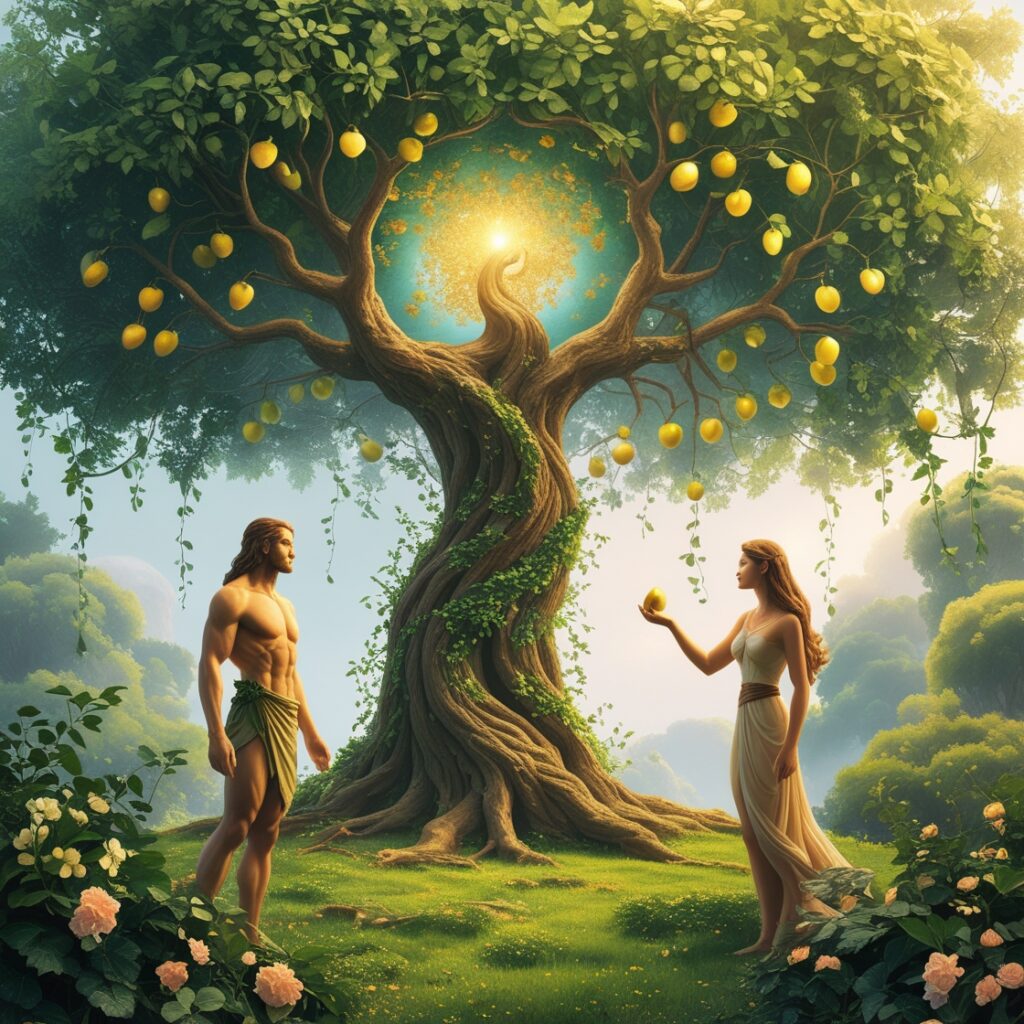
The Tree of Life, first mentioned in the Book of Genesis (Genesis 2:9, 2:16-17), is one of the central symbols in the Garden of Eden narrative. It represents the dual nature of knowledge—both the power to discern and the burden of responsibility. Eating its fruit symbolized humanity’s transition from innocence to awareness, bringing moral and existential understanding.
This tree is not merely a physical entity but a symbol of sacred, often hidden knowledge—a recurring theme throughout the Bible. Its significance evolves across the scriptures, manifesting as wisdom, divine revelation, or the pursuit of deeper truths. In a later section, we do a deeper dive in the understanding and wisdom of the Tree of Life.
Tracing Sacred Knowledge Through the Bible
Genesis: The Fall and the Awakening of Humanity
- When Adam and Eve ate the fruit of the Tree of Knowledge, they became aware of good and evil. This act marked the loss of innocence and their expulsion from Eden (Genesis 3:22-24). It established a recurring biblical theme: the pursuit of knowledge often leads to both enlightenment and consequences.
Enoch and the Watchers (Genesis 5:18-24, Book of Enoch)
- Enoch, a descendant of Adam through Seth, is described as walking closely with God. In apocryphal texts like the Book of Enoch, Enoch is taught divine secrets by angelic beings, known as the Watchers. This knowledge included astronomy, metallurgy, and writing—echoes of the tree’s dual-edged wisdom.
Moses and the Burning Bush (Exodus 3)
- Moses encounters the divine presence in the form of the burning bush, an event linked to sacred knowledge. Here, God reveals His name, “I AM WHO I AM,” and His plan for liberation, echoing themes of profound, transformative revelation.
The Ark of the Covenant (Exodus 25:10-22)
- The Ark, containing the stone tablets of the Ten Commandments, is a physical vessel of sacred knowledge. It represents divine laws given to humanity, connecting moral discernment with covenantal relationship—another reflection of the tree’s essence.
Wisdom Literature (Proverbs, Ecclesiastes, Job)
- The pursuit of wisdom, often personified as a tree of life (Proverbs 3:18), mirrors the dual nature of the Tree of Knowledge. Proverbs encourages seeking wisdom with reverence for God as its foundation (Proverbs 9:10).
The Cross as the Tree of Knowledge (New Testament)
- Some Christian traditions interpret the cross of Christ as a restored Tree of Knowledge. Through Jesus’ sacrifice, humanity gains access to redemption and spiritual enlightenment. Paul writes, “Christ redeemed us… by becoming a curse for us, for it is written: ‘Cursed is everyone who is hung on a pole'” (Galatians 3:13).
Revelation: The Tree of Life Restored (Revelation 22:1-2)
- In the final book of the Bible, the Tree of Life reappears, signifying the restoration of paradise and the healing of nations. This tree grows beside the River of the Water of Life, linking eternal life with divine wisdom and harmony.
Themes of the Tree and Sacred Knowledge
Throughout the Bible, the Tree of Knowledge symbolizes humanity’s journey to understand divine truth. Its travels through scripture illustrate the tension between seeking understanding and respecting divine boundaries. From Eden to Revelation, the story of sacred knowledge serves as a testament to humanity’s longing for connection with the divine, the costs of that pursuit, and the hope of ultimate reconciliation and enlightenment.
Enoch: The Man Who Walked With God

Enoch, a figure of profound mystery and significance, is introduced in the genealogies of Genesis as the son of Jared and the father of Methuselah, the longest-living human recorded in the Bible (Genesis 5:18-24). Born in the seventh generation from Adam through the line of Seth, Enoch’s life is marked by a singular distinction: he “walked with God.”
Unlike others in the lineage, whose lives were measured in centuries of toil and eventual death, Enoch’s story breaks the pattern. After living 365 years—a symbolic number echoing a solar year—he was taken by God, bypassing death. Genesis records, “Enoch walked faithfully with God; then he was no more, because God took him away” (Genesis 5:24). This cryptic statement implies a unique closeness to the divine, elevating Enoch above his peers.
Enoch in Extrabiblical Texts
Enoch’s significance expands in apocryphal writings, particularly the Book of Enoch (considered canonical by the Ethiopian Orthodox Church but apocryphal elsewhere). These texts portray Enoch as a righteous man chosen by God to receive heavenly revelations. He is said to have ascended to the heavens, where he was shown the workings of the cosmos, the secrets of creation, and the fates of angels and humanity.
Enoch’s narratives also include his role as a scribe, recording divine wisdom for future generations. He was tasked with admonishing the Watchers—fallen angels who corrupted humanity—and prophesying the coming judgment. These texts depict him as a mediator between the divine and mortal realms, an archetype of human potential for divine connection.
Enoch’s Legacy
Enoch’s life and legacy are foundational in Judeo-Christian and Islamic traditions. In the New Testament, his faith is celebrated as an example of righteousness: “By faith Enoch was taken from this life, so that he did not experience death… he was commended as one who pleased God” (Hebrews 11:5). Jude references Enoch’s prophecy of judgment, affirming his role as a visionary (Jude 1:14-15).
Enoch’s story symbolizes the ideal of spiritual closeness to God and the transformative power of divine wisdom. His mysterious disappearance has inspired countless interpretations, portraying him as a bridge between humanity’s earthly journey and the divine promise of eternal life.
Enoch in Sumerian Context: The Wise Mediator of the Gods
In the Sumerian tradition, parallels to the biblical Enoch are found in figures who bridge the divine and mortal realms, embodying wisdom and divine favor. Though Enoch as described in Genesis does not explicitly appear in Sumerian texts, his attributes resonate with figures like Enmeduranki, an ancient king of Sippar. Enmeduranki, like Enoch, was a chosen individual, initiated into the mysteries of the gods and endowed with sacred knowledge.
Enmeduranki: A Sumerian Prototype of Enoch
Enmeduranki, a pre-dynastic king listed in the Sumerian King List, ruled the city of Sippar, associated with the sun god Utu (Shamash in Akkadian). According to Sumerian and Akkadian texts, Enmeduranki was beloved by the gods and granted access to divine councils. He was taken into the heavens, where he was taught the secrets of divination, including the reading of oil on water and the celestial movements—a profound echo of Enoch’s heavenly ascent in the Book of Enoch.
These divine mysteries were not for Enmeduranki alone but were passed to his descendants, creating a lineage of priest-kings entrusted with maintaining the connection between the divine and the earthly. This mirrors Enoch’s role as a scribe and teacher, recording and transmitting divine wisdom.
Sacred Knowledge and Heavenly Ascent
The theme of ascent to the heavens, central to Enoch’s story, is echoed in Sumerian mythology. Kings and priests, like Enmeduranki, were seen as intermediaries who could access divine realms. This ascent was both literal and symbolic, representing a profound alignment with divine will and an understanding of cosmic order. Could “ascent to the heavens” mean migrating to a higher state of cosmic conciousness?
The Sumerian emphasis on the “Tablet of Destinies,” a divine artifact containing the decrees of the gods, also aligns with Enoch’s role as a recipient of heavenly knowledge. Such tablets held the secrets of creation and governance, reinforcing the connection between Enoch’s divine mission and Sumerian traditions of sacred wisdom.
Legacy in Sumerian Material and Biblical Reflection
The Sumerian portrayal of figures like Enmeduranki underscores the ancient Mesopotamian belief that certain individuals were chosen by the gods to act as custodians of divine knowledge. These figures were often portrayed as walking with the gods, much like Enoch in the Bible.
The Sumerian material suggests that Enoch’s story is part of a broader, ancient narrative tradition in which humanity’s connection to the divine is mediated through enlightened individuals. This connection—bridging heaven and earth—became a cornerstone of later spiritual traditions, with Enoch embodying the archetype of the wise, god-favored mediator who transcends mortality to dwell with the divine.
this baby could be the progenitor of humankind
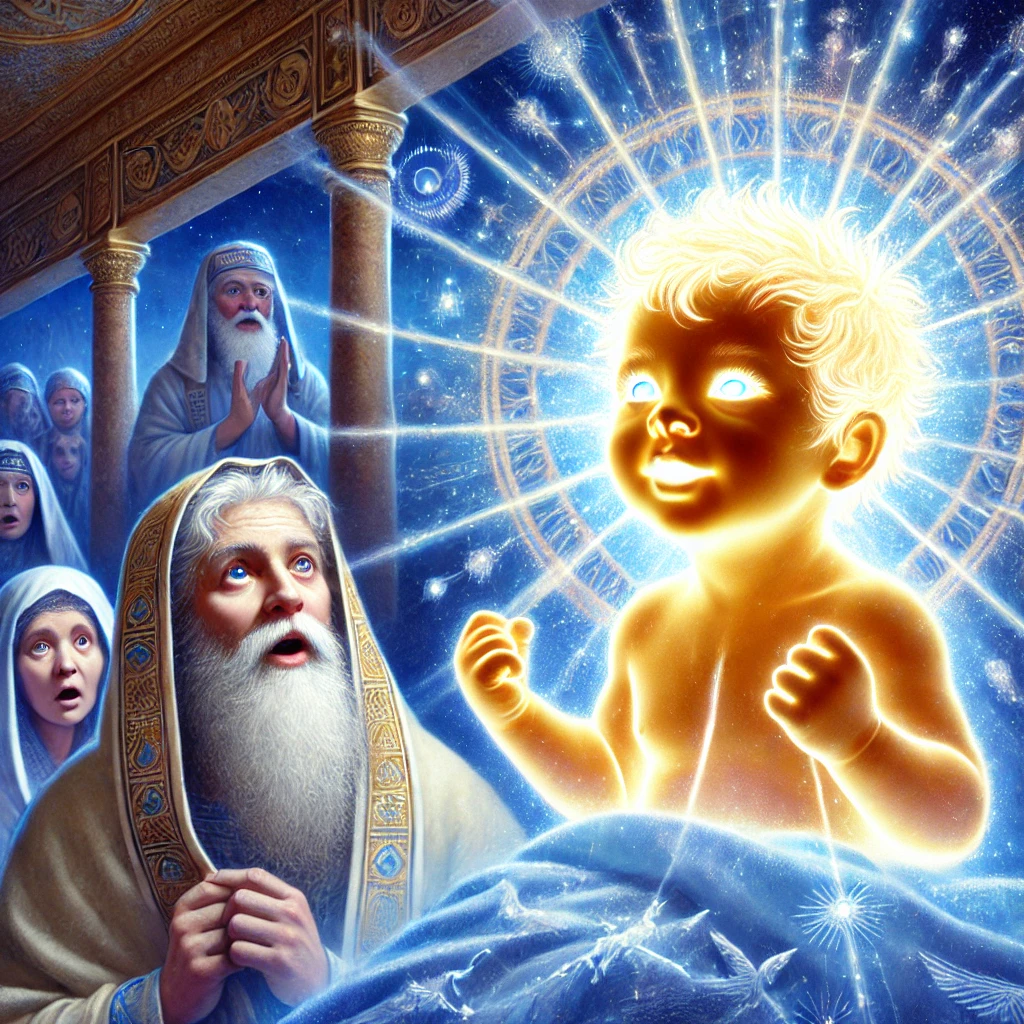
The unusual birth of Noah is detailed not in the Book of Genesis but in the Book of Enoch and the Genesis Apocryphon (one of the Dead Sea Scrolls), both ancient Jewish texts that expand on biblical narratives. According to these writings, Noah’s birth was extraordinary and caused his father, Lamech, great concern.
In the Genesis Apocryphon, Noah is described as having a radiant appearance, with skin as white as snow and hair as white as wool, and his eyes are said to have “lit up the whole house” as if they were shining. This unusual brightness and physical appearance led Lamech to suspect that Noah might not be entirely human, fearing that he might be the offspring of divine beings, such as the Nephilim or “watchers” (angels) mentioned in Enoch. Troubled, Lamech consulted his father, Methuselah, who then sought guidance from Enoch, Noah’s grandfather and a revered prophet. Enoch reassured them, prophesying that Noah’s unique nature and appearance were signs that he was chosen by God for a special purpose: to survive the coming flood and continue humanity.
This portrayal of Noah’s birth as otherworldly emphasizes his role as a divinely chosen figure and foreshadows his mission to preserve life through the flood. While these accounts are not part of the canonical Genesis story, they add fascinating layers to Noah’s character in Jewish mystical and apocryphal traditions.
Royal bloodlines and divine mission
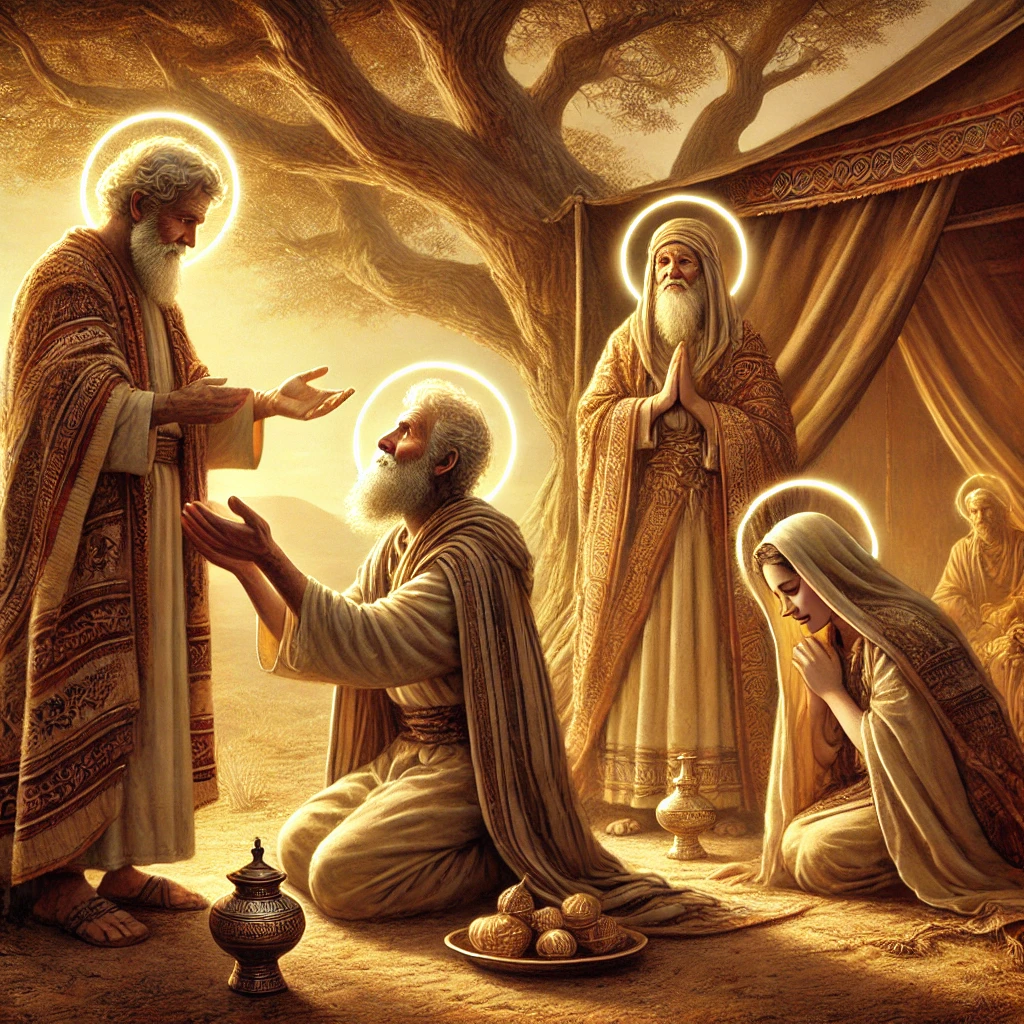
Abraham and Sarah: A Sumerian Perspective
Abraham, known as Ab-Ra-Ham in ancient Sumerian texts, is portrayed as a figure of noble lineage and divine purpose. His story, interwoven with celestial guidance, sacred covenants, and humanity’s trials, begins in the fertile plains of Mesopotamia and spans deserts, cities, and kingdoms.
The Royal Bloodline of Ab-Ra-Ham
Abraham’s origins trace back to the city of Ur, a flourishing center of Sumerian civilization and a hub of religious and political power. Born into a family of high status, Abraham was linked to priestly and royal circles that governed the ancient city under the aegis of the god Nanna (Sin), the lunar deity. His name, Ab-Ra-Ham, reflects his exalted status as “Father of a Multitude” or “Exalted Father,” highlighting his destiny to shape nations.
The Sumerian traditions recount that Abraham’s lineage was chosen by the gods to serve as intermediaries between the divine and humanity. This divine election would lead him to leave his homeland, following celestial commands.
Wanderings in the Desert and the Covenant with the Divine
Abraham’s journey began with a celestial vision—interpreted by Sumerian scribes as a message from Anu, Enlil, or Enki—urging him to leave the comforts of Ur and journey to a land promised to his descendants. Accompanied by his wife Sarai (later Sarah), his nephew Lot, and a small retinue, Abraham traversed the arid landscapes of the Sinai Peninsula and Canaan.
His life as a wanderer was marked by trials and divine assurances. In these accounts, Sarah’s beauty was so extraordinary that it caught the attention of kings. Twice, Abraham’s cunning and reliance on divine favor protected them when foreign rulers—Pharaoh in Egypt and Abimelech in Gerar—sought to take Sarah for themselves. These episodes are interpreted in Sumerian texts as tests of Abraham’s resolve and his covenant with the gods.
Fathering Two Bloodlines: The Sons of Ab-Ra-Ham
Sarah’s barrenness led her to offer her handmaiden, Hagar, to Abraham, an act echoing ancient Sumerian customs of ensuring lineage through surrogates. Hagar bore Ishmael, considered the progenitor of the Arab peoples. Yet, the divine promise was fulfilled through Isaac, born to Sarah under miraculous circumstances. Some interpretations, rooted in Sumerian lore, suggest celestial intervention akin to genetic engineering or artificial insemination by higher beings. I wonder which MEs were possibly utilized in the conceptions and birth of Isaac.
Thus, two great bloodlines emerged from Abraham. Ishmael’s descendants would forge the Arab tribes and later the Islamic faith, while Isaac’s lineage would lead to the Israelites, culminating in figures like King David and Jesus. These twin bloodlines reflect the duality of Abraham’s legacy—a bridge between nations and faiths.
Weapons of Terror and the Destruction of the Five Cities
Abraham’s connection to the “weapons of terror” and the destruction of Sodom, Gomorrah, and the other cities on the plain is a striking feature in Sumerian traditions. These texts describe celestial weapons capable of unleashing fiery destruction, often attributed to the gods. The annihilation of these cities, recorded in both the Bible and Sumerian accounts, is interpreted as divine retribution for moral corruption and the breach of cosmic laws.
Abraham, though not directly responsible for wielding these weapons, played a crucial role as an intermediary. The texts recount his plea to spare the cities if righteous individuals could be found within them. His negotiations reflect his standing as a trusted servant of the divine and an advocate for humanity.
Other Key Events and Contributions
The Treaty with Melchizedek
Abraham’s meeting with Melchizedek, king of Salem and priest of El Elyon, symbolizes a unification of spiritual and temporal authority. The Sumerian tradition honors this event as a moment of profound alignment between divine will and human leadership.The Binding of Isaac
The near-sacrifice of Isaac, interpreted in Sumerian traditions as a test of loyalty to the divine, solidifies Abraham’s unwavering faith. The intervention of a celestial messenger underscores the gods’ control over life and destiny.The Expansion of His Legacy
Abraham’s influence extended beyond his immediate family. His interactions with neighboring tribes, kings, and rulers established him as a figure of immense spiritual and political importance, laying the foundation for future nations.
Abraham and Sarah: Archetypes of Faith and Leadership
In the Sumerian context, Abraham and Sarah embody humanity’s struggle to reconcile divine guidance with earthly challenges. Their story, marked by celestial encounters, miraculous births, and the forging of nations, serves as a testament to the intertwining of divine and human destinies. Through their lineage, Abraham and Sarah not only shaped the course of history but also bridged the gap between mortal ambition and celestial purpose, ensuring their place as enduring symbols of faith and resilience in the ancient world.
Awaken the spirit hack 11: The Seeds of Global Strife

Abraham, Sarah, and Hagar’s Legacy
The story of Abraham, Sarah, and Hagar is one of divine promises and human decisions that resonate through millennia, shaping the spiritual, political, and cultural landscapes of the world. By examining the events that unfolded between these three pivotal figures, we uncover the roots of tensions that echo into 2025 and beyond.
As you transition to exploring a new understanding of God and the way revealed in the New Testament, this narrative serves as a bridge—showing both the conflicts born of human frailty and the redemptive path offered through divine intervention.
The Genesis of Two Bloodlines
Abraham, Sarah, and Hagar symbolize a turning point in humanity’s story, one deeply intertwined with divine covenants and human choices. Sarah’s barrenness and the cultural pressures to produce heirs led to Hagar, Sarah’s Egyptian maidservant, becoming a surrogate mother. Hagar bore Ishmael, the forefather of the Arab peoples. Later, Sarah miraculously bore Isaac, the child of promise, whose lineage would lead to the Israelites and ultimately to Jesus.
This division in Abraham’s lineage planted the seeds of rivalry:
- Ishmael’s descendants came to represent nations outside the covenant given to Isaac, yet blessed by God with great numbers and strength (Genesis 17:20).
- Isaac’s descendants carried the promise of the covenant, which included the establishment of a chosen people and the eventual arrival of the Messiah.
This duality, reflecting God’s universal blessing and particular election, set the stage for centuries of tension. The competing claims to spiritual inheritance between these two lineages have fueled theological disputes, territorial conflicts, and cultural divides.
Hagar and Sarah: Archetypes of Division
Hagar and Sarah symbolize more than two women; they represent opposing paradigms of divine relationship:
- Hagar represents the path of human effort to achieve divine promises. Ishmael’s birth, while blessed, was a result of Sarah and Abraham’s impatience and reliance on human solutions.
- Sarah represents the path of divine intervention and grace. Isaac’s miraculous birth embodies the idea that God’s promises are fulfilled in God’s time and through faith, not human effort.
Paul later revisits this division in the New Testament, allegorizing Hagar as representing the old covenant of law and Sarah as the new covenant of grace through Christ (Galatians 4:21-31). This shift highlights the need for a new way—one that moves beyond division into unity through a deeper spiritual understanding.
The Roots of Strife in 2025
The conflicts between Isaac and Ishmael’s descendants mirror deeper human tendencies toward tribalism, competition, and fear. In 2025, the global landscape is fraught with the consequences of these ancient divisions:
- Religious Strife: The Abrahamic faiths—Judaism, Christianity, and Islam—continue to grapple with theological differences rooted in these early stories.
- Geopolitical Tensions: The Middle East, the birthplace of Abraham’s story, remains a focal point of conflict, with disputes over land, resources, and spiritual claims.
- Cultural Polarization: The competing narratives of chosenness and divine blessing perpetuate divisions, reinforcing cycles of misunderstanding and distrust.
These issues stem from humanity’s struggle to reconcile competing claims to divine favor, a legacy directly traceable to Abraham’s family dynamics.
Transitioning to a New Way in the New Testament
The New Testament offers a transformative vision for addressing the divisions sown by Abraham, Sarah, and Hagar’s story. Through Jesus Christ, a new covenant is established—one that transcends bloodlines, laws, and tribal identities. Key themes include:
- Universal Reconciliation: Jesus’ teachings focus on breaking down barriers between Jew and Gentile, offering a vision of unity under God (Ephesians 2:14-18).
- A New Family of Faith: In Christ, the emphasis shifts from physical lineage to spiritual adoption. “If you belong to Christ, then you are Abraham’s seed, and heirs according to the promise” (Galatians 3:29). This redefines inheritance, making it accessible to all through faith.
- Love and Forgiveness as the Way: Jesus introduces love as the ultimate law, replacing cycles of conflict with the call to love one’s neighbor and enemy alike (Matthew 22:37-40, Matthew 5:43-48).
By following this new way, humanity is invited to move beyond the divisions rooted in Abraham’s story and embrace a universal kinship that reflects God’s ultimate purpose.
Conclusion of Part 4: Extraterrestrials and the Old Testament and spiritual ptsd
As we conclude this exploration of extraterrestrial influence in the Old Testament, it becomes evident that humanity’s ancient history may be far more intertwined with advanced beings than previously imagined. From the enigmatic encounters of the patriarchs to the cataclysmic events that shaped civilizations, we see a pattern of guidance, intervention, and at times, destruction. These stories—when examined through the lens of extraterrestrial influence—raise profound questions about our origins, purpose, and ultimate destiny.
Could the biblical references to fiery chariots, angelic visitations, and heavenly realms be echoes of interactions with advanced beings from beyond our world? And if so, were these beings merely observers, or were they active participants in shaping human evolution?
These mysteries do not end with the Old Testament. On the contrary, they gain even greater significance when we turn to the New Testament. In the life and teachings of Jesus, we encounter a message of spiritual awakening and universal love that resonates across time and space. Was Jesus merely a man, or was he, as some suggest, a divine emissary or even a being of cosmic origins?
Transition to Part 2: The New Testament
With these questions in mind, we now pivot to the New Testament, where the story takes on new dimensions. In this section, we will explore how the teachings of Jesus reflect a deeper, perhaps intergalactic, understanding of consciousness and spiritual evolution. Could his message of the Kingdom of Heaven being within us align with the guidance of advanced extraterrestrial beings? Is it possible that Jesus, as a spiritual figure, holds the key to humanity’s next stage of evolution—one that bridges the gap between earthly existence and cosmic awakening?
Join us in Part 2 as we delve into the sacred texts of the New Testament, seeking to uncover hidden insights, cosmic connections, and a message of hope for humanity’s future.
